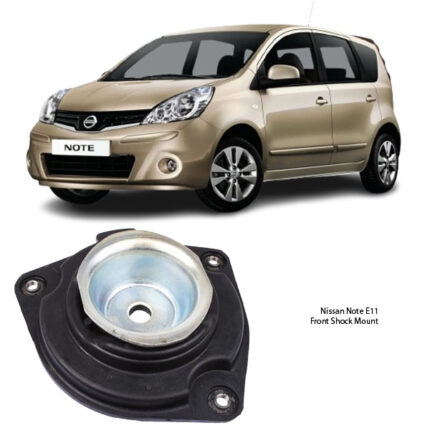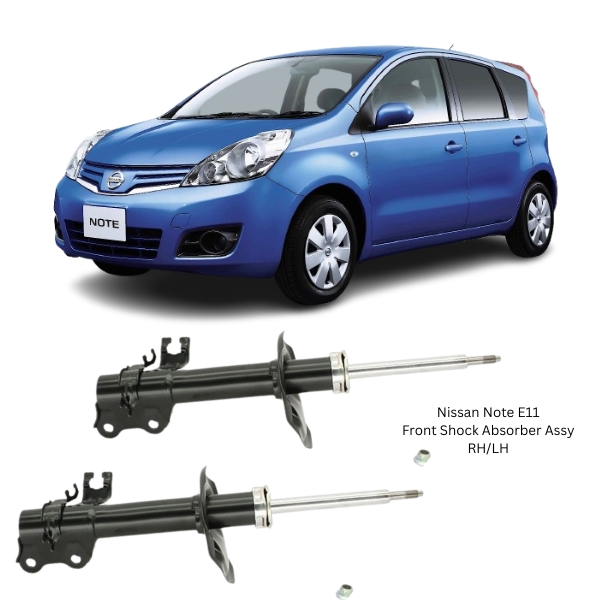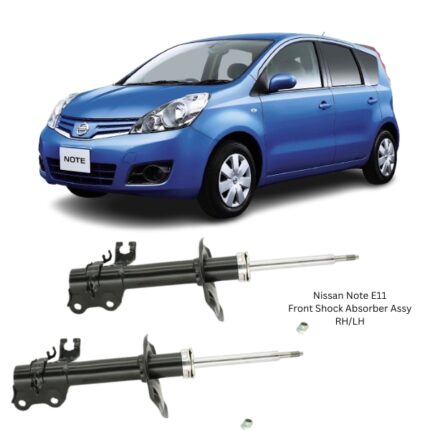Get Nissan Note E11 Front Shock Absorber Assy 333396 in Kenya
The Front Shock Absorber Assembly is one of the most critical components in a vehicle’s suspension system. Designed to absorb and dampen shocks from the road surface, it controls the movement of the front suspension and ensures a smooth and stable driving experience. Located at each front wheel, this assembly directly influences steering response, braking efficiency, ride comfort, and tire longevity.
Shock absorbers do not carry vehicle weight; instead, they manage energy from road impacts by converting kinetic energy into heat through fluid resistance. The front shock absorber plays a particularly important role because it also supports the vehicle’s steering geometry. A properly functioning unit ensures that the front wheels remain in consistent contact with the road surface, providing safe and predictable handling.
Construction and Key Components
A standard Front Shock Absorber Assembly consists of several precision-engineered parts, designed to work in harmony under a wide range of driving conditions. These include:
-
Shock Body (Outer Tube) – A strong metal casing that houses the internal components. Made from heavy-duty steel or aluminum for strength and durability.
-
Piston Rod and Piston Valve – The rod moves up and down inside the cylinder. The piston, attached to the rod, contains small orifices and valves that regulate fluid flow and control damping force.
-
Hydraulic Fluid or Gas Chamber – Filled with hydraulic oil, or in some designs, a mix of oil and pressurized nitrogen gas to resist foaming and heat buildup.
-
Compression and Rebound Valves – These control the flow of fluid during both compression and rebound strokes, ensuring precise suspension movement.
-
Dust Boot/Seal – A protective cover that prevents dirt, moisture, and road debris from damaging the rod and internal seals.
-
Mounting Bushings and Eyelets – Provide vibration isolation and a secure connection between the shock and the vehicle’s chassis and suspension arm.
-
Bump Stop – Prevents metal-to-metal contact during full compression and absorbs impact loads.
Front shock absorbers can be of the twin-tube or mono-tube design. Twin-tube units are commonly used for comfort and daily driving, while mono-tube types offer better heat dissipation and performance in demanding conditions.
Function and Operational Purpose
The Front Shock Absorber Assembly performs a series of essential functions:
-
Damping Suspension Movement – Controls the rate at which the front wheels move up and down after encountering bumps or potholes.
-
Enhancing Steering Stability – Works alongside the steering system to maintain precise control during cornering and quick maneuvers.
-
Reducing Body Roll – Limits excessive body movement during turning or lane changes, improving ride balance and safety.
-
Maintaining Tire Contact – Ensures the front tires stay firmly planted on the road for optimal grip and braking performance.
-
Minimizing Bounce and Oscillation – Absorbs kinetic energy from the springs and dissipates it smoothly to prevent continuous bouncing.
Whether on smooth highways or rugged roads, front shocks help maintain vehicle stability and enhance driver confidence.
Benefits of a High-Quality Front Shock Absorber
Upgrading to a well-constructed front shock absorber assembly delivers significant performance, safety, and comfort advantages:
-
Enhanced Ride Comfort – Absorbs irregularities in the road surface, offering a smoother and quieter ride.
-
Improved Steering Precision – Reduces front-end wander and improves directional stability.
-
Reduced Braking Distance – Maintains tire contact and reduces dive under hard braking.
-
Minimized Tire Wear – Prevents tire cupping or scalloping by maintaining even pressure on the road surface.
-
Increased Suspension Lifespan – Reduces stress on ball joints, control arms, and other suspension parts.
-
Quiet Operation – Modern shocks include noise-reduction features and high-quality bushings that minimize harshness and vibration.
These benefits are especially noticeable in high-mileage or aging suspension systems, where ride quality and handling have degraded over time.
Symptoms of a Failing Front Shock Absorber
Over time, shock absorbers wear out due to constant movement, pressure changes, and environmental exposure. Common symptoms of front shock failure include:
-
Excessive Bouncing – If the front end continues to bounce after hitting a bump, the shock may no longer be damping properly.
-
Nose Dive When Braking – A noticeable dip in the front when braking indicates worn or soft front shocks.
-
Poor Handling and Steering Response – Increased body roll or vagueness in the steering wheel can signal compromised shock performance.
-
Uneven Tire Wear – Cupped or scalloped tire tread patterns are often linked to insufficient damping.
-
Fluid Leaks – Visible oil or residue on the shock body means the internal seals have failed.
-
Knocking or Clunking Noises – Can result from damaged internal components or loose mounting bushings.
If any of these symptoms are present, the shock absorber should be inspected and replaced promptly to maintain safe driving performance.
Installation Guidelines
Installing a Front Shock Absorber Assembly requires attention to detail and proper alignment procedures. A general installation process includes:
-
Raise the Vehicle Securely – Use jack stands to safely elevate the front of the vehicle.
-
Remove the Wheel – Gain access to the shock assembly.
-
Disconnect the Shock – Remove mounting bolts from the top and bottom of the assembly.
-
Inspect Related Components – Check bushings, mounts, and surrounding parts for wear or damage.
-
Install the New Assembly – Position the new shock and torque all bolts to the manufacturer’s specifications.
-
Repeat on Opposite Side – For balanced performance, both front shocks should be replaced simultaneously.
-
Test and Align – After installation, perform a road test and check wheel alignment if necessary.
Depending on the vehicle, some front shock absorbers may be integrated into strut assemblies, which may require additional steps, such as spring compression and top mount transfer.
Maintenance and Inspection Tips
Although most front shock absorbers are sealed and maintenance-free, regular inspection can prolong their life:
-
Check for Leaks and Rust – Monitor for oil seepage or corrosion around the shock body and piston rod.
-
Inspect Dust Boots – Torn boots can allow dirt and moisture to enter and damage seals.
-
Listen for Noises – Any clunking, squeaking, or rattling during driving may indicate a suspension issue.
-
Observe Ride Quality – Any sudden deterioration in ride comfort or steering performance warrants investigation.
-
Avoid Overloading – Excess vehicle weight or hard driving over rough terrain can accelerate shock wear.
Routine checks during scheduled service intervals help catch issues early and maintain smooth, reliable performance.
Fitment and Compatibility
To ensure proper performance, the Front Shock Absorber Assembly must be correctly matched to the vehicle’s suspension system in terms of:
-
Length and travel specifications
-
Damping rate (valving)
-
Mounting style (eyelet, stud, or bracket)
-
Weight capacity
-
Chassis and wheel configuration
Only shock absorbers that meet or exceed OEM specifications should be installed to preserve suspension geometry and handling characteristics.
Follow us on Facebook for more parts.




